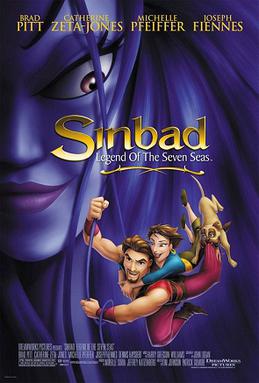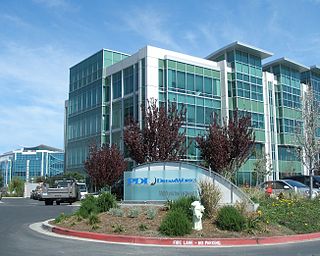
Computer animation is the process used for digitally generating animations. The more general term computer-generated imagery (CGI) encompasses both static scenes and dynamic images, while computer animation only refers to moving images. Modern computer animation usually uses 3D computer graphics. The animation's target is sometimes the computer itself, while other times it is film.
OpenEXR is a high-dynamic range, multi-channel raster file format, released as an open standard along with a set of software tools created by Industrial Light & Magic (ILM), under a free software license similar to the BSD license.

Sinbad: Legend of the Seven Seas is a 2003 American animated adventure film produced by DreamWorks Animation and distributed by DreamWorks Pictures. Like the studio's previous film, Spirit: Stallion of the Cimarron (2002), the film combines traditional animation with some computer animation. Featuring the character Sinbad the Sailor, it was directed by Tim Johnson and Patrick Gilmore and written by John Logan, and stars the voices of Brad Pitt, Catherine Zeta-Jones, Michelle Pfeiffer, and Joseph Fiennes. It covers the story of Sinbad, a pirate who travels the sea with his dog and his loyal crew, alongside Marina, the fiancée of his childhood friend Prince Proteus, to recover the stolen Book of Peace from Eris to save Proteus from approving Sinbad's death sentence. The film blends elements from One Thousand and One Nights and classical mythology.
Visual effects is the process by which imagery is created or manipulated outside the context of a live-action shot in filmmaking and video production. The integration of live-action footage and other live-action footage or CGI elements to create realistic imagery is called VFX.

LightWave 3D is a 3D computer graphics program developed by LightWave Digital. It has been used in films, television, motion graphics, digital matte painting, visual effects, video game development, product design, architectural visualizations, virtual production, music videos, pre-visualizations and advertising.

Scientific visualization is an interdisciplinary branch of science concerned with the visualization of scientific phenomena. It is also considered a subset of computer graphics, a branch of computer science. The purpose of scientific visualization is to graphically illustrate scientific data to enable scientists to understand, illustrate, and glean insight from their data. Research into how people read and misread various types of visualizations is helping to determine what types and features of visualizations are most understandable and effective in conveying information.

Houdini is a 3D animation software application developed by Toronto-based SideFX, who adapted it from the PRISMS suite of procedural generation software tools.

DreamWorks Animation LLC (DWA) (also known as DreamWorks Animation Studios or simply DreamWorks) is an American animation studio owned by Universal Pictures, a division of NBCUniversal, which is itself a division of Comcast. The studio has released a total of 46 feature films as of January 2024. Their catalogue includes several of the highest-grossing animated films of all time, with Shrek 2 (2004) having been the highest at the time of its release. The studio's first film, Antz, was released on October 2, 1998, and its latest film was Trolls Band Together on November 17, 2023; their upcoming slate of films includes the Netflix original film Orion and the Dark on February 2, 2024, and the theatrical films Kung Fu Panda 4 on March 8, 2024, and The Wild Robot on September 20, 2024. Additionally, DreamWorks has reserved three release dates for animated films: January 31, 2025, August 1, 2025, and September 26, 2025.

Pacific Data Images (PDI) was an American Visual effects and computer animation production company based in Redwood City, California, that was bought by DreamWorks SKG in 2000. It was renamed PDI/DreamWorks and was owned by DreamWorks Animation.

Virtual cinematography is the set of cinematographic techniques performed in a computer graphics environment. It includes a wide variety of subjects like photographing real objects, often with stereo or multi-camera setup, for the purpose of recreating them as three-dimensional objects and algorithms for the automated creation of real and simulated camera angles. Virtual cinematography can be used to shoot scenes from otherwise impossible camera angles, create the photography of animated films, and manipulate the appearance of computer-generated effects.

3D rendering is the 3D computer graphics process of converting 3D models into 2D images on a computer. 3D renders may include photorealistic effects or non-photorealistic styles.

Vue is a software tool for world generation by e-on software with support for many visual effects, animations and various other features. The tool has been used in several feature-length movies.

3D computer graphics, sometimes called CGI, 3-D-CGI or three-dimensional computer graphics, are graphics that use a three-dimensional representation of geometric data that is stored in the computer for the purposes of performing calculations and rendering digital images, usually 2D images but sometimes 3D images. The resulting images may be stored for viewing later or displayed in real time.
Web2py is an open-source web application framework written in the Python programming language. Web2py allows web developers to program dynamic web content using Python. Web2py is designed to help reduce tedious web development tasks, such as developing web forms from scratch, although a web developer may build a form from scratch if required.

Computer graphics deals with generating images and art with the aid of computers. Today, computer graphics is a core technology in digital photography, film, video games, digital art, cell phone and computer displays, and many specialized applications. A great deal of specialized hardware and software has been developed, with the displays of most devices being driven by computer graphics hardware. It is a vast and recently developed area of computer science. The phrase was coined in 1960 by computer graphics researchers Verne Hudson and William Fetter of Boeing. It is often abbreviated as CG, or typically in the context of film as computer generated imagery (CGI). The non-artistic aspects of computer graphics are the subject of computer science research.

Rise of the Guardians is a 2012 American animated fantasy action-adventure film produced by DreamWorks Animation and distributed by Paramount Pictures. The film was directed by Peter Ramsey from a screenplay by David Lindsay-Abaire, based on the book series The Guardians of Childhood and the short film The Man in the Moon by William Joyce. It stars the voices of Chris Pine, Alec Baldwin, Jude Law, Isla Fisher, and Hugh Jackman. The film tells a story about Guardians Santa Claus, the Tooth Fairy, the Easter Bunny, and the Sandman, who enlist Jack Frost to stop the evil Pitch Black from engulfing the world in darkness in a fight of dreams.
Maxwell Render is an unbiased 3D render engine, developed by Next Limit Technologies in Madrid, Spain. This stand-alone software is used in the film, animation, and VFX industry, as well as in architectural and product design visualization. It offers various plug-ins for 3D/CAD and post production applications.
The history of computer animation began as early as the 1940s and 1950s, when people began to experiment with computer graphics – most notably by John Whitney. It was only by the early 1960s when digital computers had become widely established, that new avenues for innovative computer graphics blossomed. Initially, uses were mainly for scientific, engineering and other research purposes, but artistic experimentation began to make its appearance by the mid-1960s – most notably by Dr. Thomas Calvert. By the mid-1970s, many such efforts were beginning to enter into public media. Much computer graphics at this time involved 2-D imagery, though increasingly as computer power improved, efforts to achieve 3-D realism became the emphasis. By the late 1980s, photo-realistic 3-D was beginning to appear in film movies, and by mid-1990s had developed to the point where 3-D animation could be used for entire feature film production.

Computer-generated imagery (CGI) is a specific-technology or application of computer graphics for creating or improving images in art, printed media, simulators, videos and video games. These images are either static or dynamic. CGI both refers to 2D computer graphics and 3D computer graphics with the purpose of designing characters, virtual worlds, or scenes and special effects. The application of CGI for creating/improving animations is called computer animation, or CGI animation.








